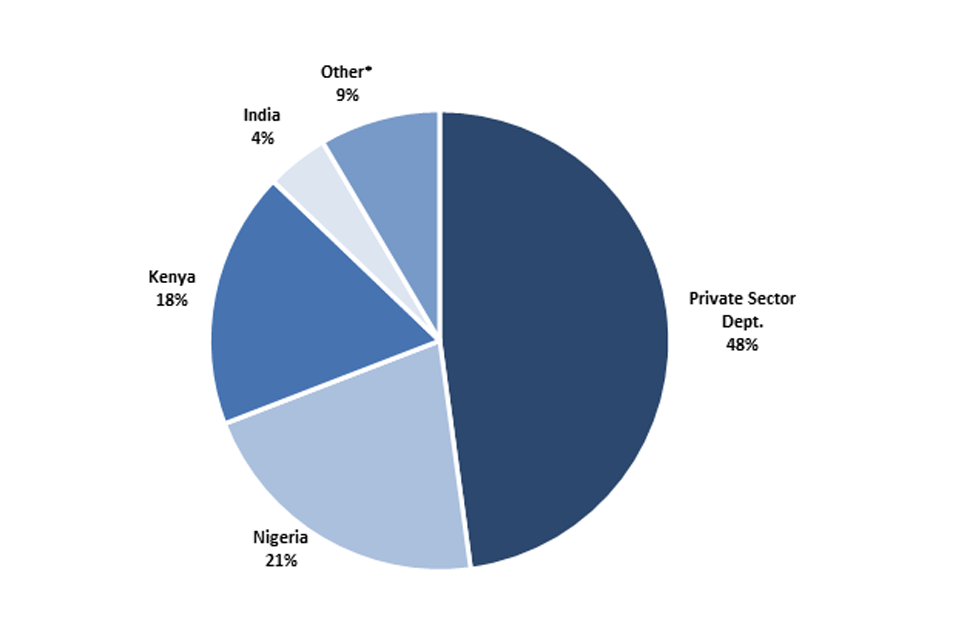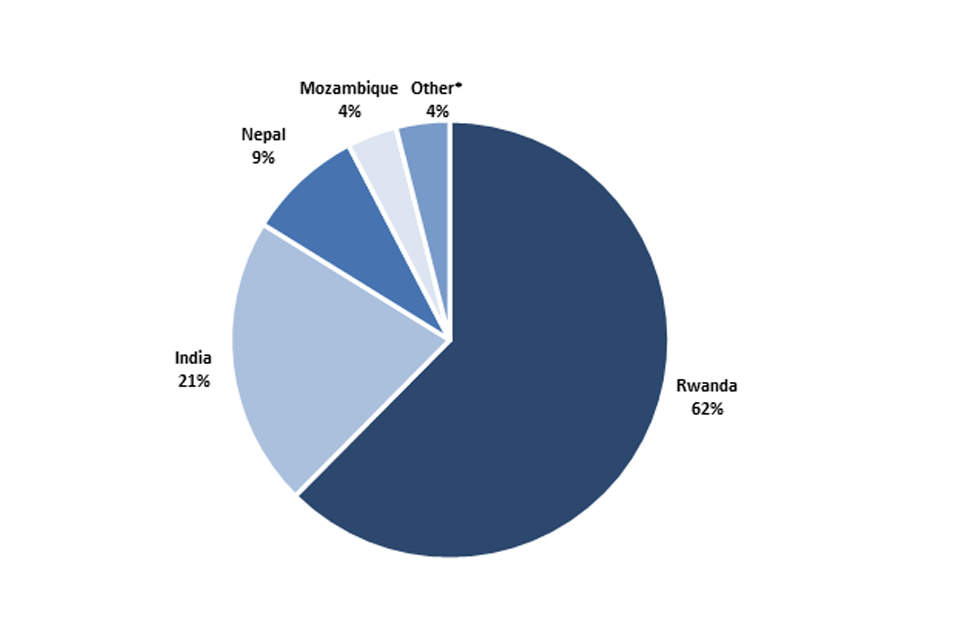DFID Annual Report and Accounts 2014 to 2015 Results achieved by sector: Wealth creation
Published 16 July 2015
Two important aspects of wealth creation are an individual’s ability to access financial services and their ability to have secure rights over their land and other property.
Financial inclusion has been broadly recognized as critical in reducing poverty and achieving inclusive economic growth. Financial inclusion is not an end in itself, but a means to an end—there is growing evidence that it has substantial benefits for individuals. Studies show that when people participate in the financial system, they are better able to start and expand businesses, invest in education, manage risk, and absorb financial shocks. Access to accounts and to savings and payment mechanisms increases savings, empowers women, and boosts productive investment and consumption. Access to credit also has positive effects on consumption—as well as on employment status and income and on some aspects of mental health and outlook.
An estimated 2 billion adults do not have access to formal financial services. A World Bank-Gallup survey in 148 countries in 2014 reported that 66% of the adults in Sub-Saharan Africa and 54% of adults in South Asia do not have access to formal financial services, compared to only 9% in high-income countries. There is a large gender gap in access to financial services. Globally, 58% of women had access to financial services in 2014, compared to 65% for men. In developing economies the gender gap is even higher at 9 percentage points. Many people lack access to financial services in the sense that these services have prohibitive costs or that there are barriers to their use, such as regulations requiring onerous paperwork, travel distance, legal hurdles, or other market failures. There is growing recognition that most of the barriers that limit access to services can be overcome by better policies.
Evidence is strong that secure land and other property rights enable sustainable and inclusive economic development, and reduce extreme poverty while empowering women. Insecure land rights act as a deterrent for productivity, economic growth and innovation. Weak tenure rights can also cause and exacerbate conflict.
As a key economic institution, secure land and property rights sit at the heart of the UK’s ‘golden thread’ vision for international development and poverty reduction. DFID is committed to scaling up programmes that improve the security of land tenure rights in developing countries, particularly for women and girls. The programmes contributing to this indicator tackle specific challenges to the security of rights to land and other property, especially for the poor, which make it more difficult for individuals, communities and businesses to invest and get a good return from their assets.
1. DFID commitment
In UK aid: Changing lives, delivering results DFID has a commitment to:
- provide more than 50 million people with access to financial services to help them work their way out of poverty by March 2015
- secure the right to land and property for more than 6 million people, of whom 50% will be women, by March 2015. DFID’s Strategic Vision for Girls and Women made a further and more ambitious commitment to secure access to land for 4.5 million women
2. Indicators used to measure progress
There are 2 wealth creation indicators included in the DFID Results Framework to measure progress:
- number of people with access to financial services as a result of DFID support
- number of people supported through DFID to improve their rights to land and property
3. Results achieved
By 2014-15, DFID had achieved the following results:
- supported an estimated 68.9 million people to gain access to financial services
- helped 5.8 million people to secure their land and property rights
The results for the financial access indicator come from a variety of financial sector development programmes focusing on direct delivery of financial services to the unbanked, and on development of markets for financial services with a view to paving the way for the private sector to serve the needs of the poor. DFID is prioritising harnessing of technology in delivery of financial services to the poor because the developing countries are more connected digitally than they are connected through brick and mortar bank branches. Technology is making it possible for the poor people to access financial services at affordable cost and conveniently without having to travel long distances. For example, while only 2 % of adults worldwide have a mobile money account, in Sub-Saharan Africa 12 % do. All 13 countries around the world where the share of adults with a mobile money account is 10 % or more are in Sub-Saharan Africa.
The indicator is not a direct measure of poverty but rather a measure of access to financial services such as credit, savings/deposits, insurance, leasing and transfer payments. The data mainly focuses on bilateral activities but in the case of multi-donor funded programmes, results are attributed to DFID on the basis of DFID’s share in the total programme cost.
We are on track to support 6 million people to improve their rights to land and property, having supported 5.8 million people, including more than 2.5 million women, already. We will work hard to maximise the benefits for women over the remainder of the delivery period and beyond. Programmes contributing to this indicator improve up to date and collectable land tenure, use and ownership information; support the delimitation or registration of communal land; and strengthen recognition of women’s user and ownership rights.
In addition to further upscaling our bilateral programmes, we are working hard to transform land governance in line with the globally agreed good practice principles of the Voluntary Guidelines on Land Tenure. Land and other property rights are a key element of DFID’s Economic Development work. We are supporting improved land tenure security through improved global data, information and evidence. We are working with the private sector to deliver inclusive growth through responsible land-based investments. We are trialling innovative tools to register property rights, and are providing support to citizens and communities, to engage on land with governments and investors, and to strengthen transparency and accountability. We are also working with multilateral organisations, in particular the UN Food and Agriculture Organisation and the World Bank, to maximise our contribution to lasting change for the poor.
4. Progress towards DFID results commitments
Results achieved up to 2014-15 inclusive
| Indicator | Indicator type | Results Commitment | Male | Female | Not identified | Total |
|---|---|---|---|---|---|---|
| Number of people with access to financial services as a result of DFID support* | Peak year | 50,000,000 | 32,290,000 | 35,920,000 | 680,000 | 68,900,000 |
| Number of people supported through DFID programmes to improve their rights to land and property | Cumulative | 6,000,000 | 3,200,000 | 2,580,000 | 80,000 | 5,860,000 |
*Results delivered through both multilateral and bilateral channels
5. Results achieved by country/department
The largest contributor to the financial access indicator is DFID’s Private Sector Department (PSD) which provides central funding to programmes operating in a wide range of countries. With regard to improvements to land and property rights, the highest number of people supported has been in Rwanda, followed by India and Nepal with over 90% of the results delivered in these countries. In India, for example, over 1.2 million men and women have already achieved tenure security for their land.
5.1 Number of people with access to financial services as a result of DFID support (by country/department)

Number of people with access to financial services as a result of DFID support (by country/department)
5.2 Number of people supported through DFID programmes to improve their rights to land and property (by country/department)

Number of people supported through DFID programmes to improve their rights to land and property (by country/department)
6. Results achieved by multilateral organisations
The following results are delivered by multilateral organisations, and fall broadly within the wealth creation sector. These indicators were included in the multilateral section of DFID’s Results Framework. The results presented here are based on all funding that the multilateral receives, not just funding from DFID or the UK. These results are presented alongside DFID’s share of core funding to the multilateral organisations, in order to illustrate that DFID contributes a share of those results. Multilateral abbreviations and results sources can be found in the results technical notes.
| Indicator | Multilateral | Reporting period | Latest Results | DFID’s contribution as a % of total core funding[footnote 1] |
|---|---|---|---|---|
| Number of microfinance accounts opened or end borrowers reached | AsDB[footnote 2] | 2014 | 833,000 | 5 |
| Number of micro/ small/ medium productive enterprises financed | IADB[footnote 2] | 2014 | 276,000 | 2 |
| Number of active borrowers in micro-finance | IFAD | 2013 | 6,230,000 | 7 |
| Number of voluntary savers | IFAD | 2013 | 19,060,000 | 7 |
| Number of housing loans | IFC[footnote 3] | FY 2013-14 | 74,000 | 5 |
| Number of microfinance loans | IFC[footnote 3] | FY 2013-14 | 22,900,000 | 5 |
| Number of SME loans | IFC[footnote 3] | FY 2013-14 | 5,800,000 | 5 |
| Number of long-term jobs created | PIDG | Cumulative data to 2014 | 214,000 | 81 |
-
The DFID burden share presented here are not suitable to calculate a DFID results attribution of multilateral results. The results presented in this table are achieved through all funding streams that the multilateral receive, not just limited to core funding. ↩
-
Burden share relates to the concessionary fund only. The results presented are achieved through concessionary and non-concessionary funds of the Bank. ↩ ↩2
-
The UK has a 5% IFC shareholding, with contribution in the past. However, DFID has not contributed to IFC since 1991 ↩ ↩2 ↩3
